How to Organize an Estate Sale A Practical Guide
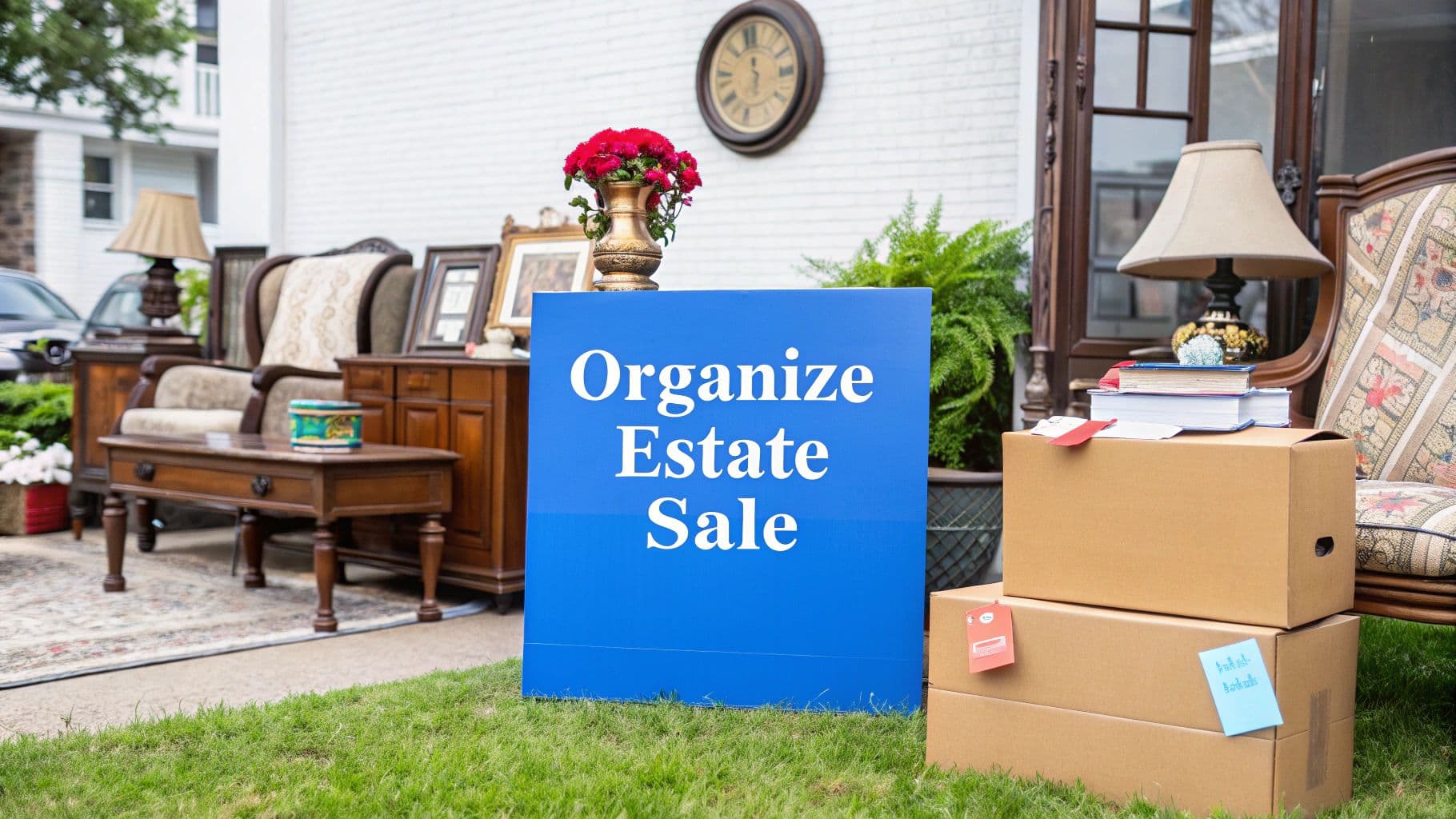
Running an estate sale is a big project, and it usually pops up during an already stressful time—maybe you're dealing with a loss, helping a parent downsize, or managing a big move yourself. The number of tasks can feel overwhelming.
The very first decision you need to make is a big one: will you handle it yourself, or is it better to bring in a professional estate sale company?
Your First Steps in Organizing an Estate Sale
Going the DIY route with a platform like DIYAuctions gives you total control over the process and means you keep more of the profits. But it also means you’re doing the legwork. On the other hand, hiring a full-service company takes a lot off your plate, but it comes at a steep price. Their commissions, which cover everything from staffing to advertising, typically eat up 25-40% of your total sales. Digging into the financials of an estate sale can help you figure out which path makes the most sense for you.
The Estate Sale Journey at a Glance
No matter which way you go, understanding the whole journey from start to finish is the best way to keep the stress down. When you break down how to organize an estate sale into smaller, more manageable stages, it feels less like a mountain to climb.
Think of it as a series of smaller projects:
- The Initial Plan: This is where you lock in your sale dates, nail down your strategy (DIY vs. pro), and start thinking about how you'll get the word out.
- Sorting & Cataloging: You’ll need to go through everything and decide what to keep, sell, donate, or toss. This is usually the most emotional and time-consuming step.
- Pricing & Staging: Once you know what you're selling, it’s time to research what things are worth, price them clearly, and then set up the house so it feels like a real shop.
- Marketing the Sale: This is all about getting people in the door. You'll use online listings, social media, and good old-fashioned signs to build buzz and attract a crowd of buyers.
- Sale Day Operations: Time to open the doors! This phase is all about managing the flow of customers, handling payments, and making sure everything runs smoothly and securely.
- The Post-Sale Wrap-Up: After the last customer leaves, you'll arrange for donation pickups, deal with any unsold items, and give the property a final clean-out.
To give you a clearer picture of how this all fits together, here’s a basic timeline you can follow.
Estate Sale Planning Timeline Overview
This table breaks down the entire process into distinct phases, showing you what needs to be done and when. Planning ahead is the key to a successful, low-stress sale.
| Phase | Key Activities | Recommended Timing |
|---|---|---|
| Foundation & Planning | Decide on DIY vs. professional hire. Set sale and pickup dates. Begin initial sorting. | 4–6 Weeks Out |
| Inventory & Cataloging | Go room-by-room. Photograph, measure, and describe every item for sale. | 3–4 Weeks Out |
| Pricing & Staging | Research values and set starting bids. Arrange items for easy viewing and pickup. | 2 Weeks Out |
| Marketing Push | Launch your online sale. Promote heavily on social media and local groups. | 1 Week Out |
| Sale & Pickup | Manage the live online auction. Host the scheduled pickup event. | Sale Week |
| Final Wrap-Up | Coordinate donations. Arrange for disposal of unsold items. Final property clean-out. | 1–3 Days Post-Sale |
As you can see, each step logically follows the one before it, building momentum toward a successful event.
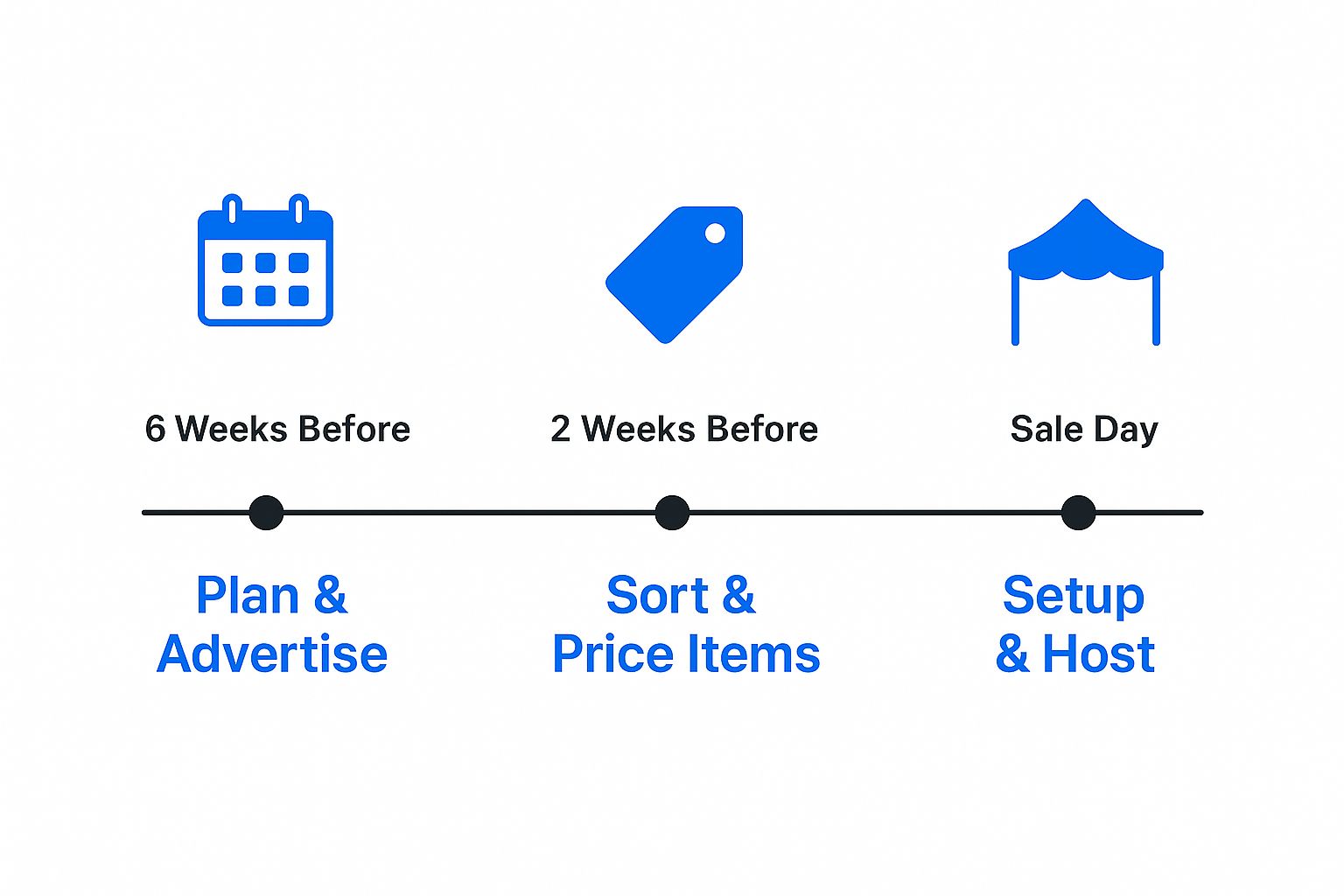
Spreading the work out over several weeks is the secret sauce. Trying to cram everything into a few days is a recipe for burnout. Give yourself the gift of time—it makes all the difference.
Deciding What to Sell and How to Price It
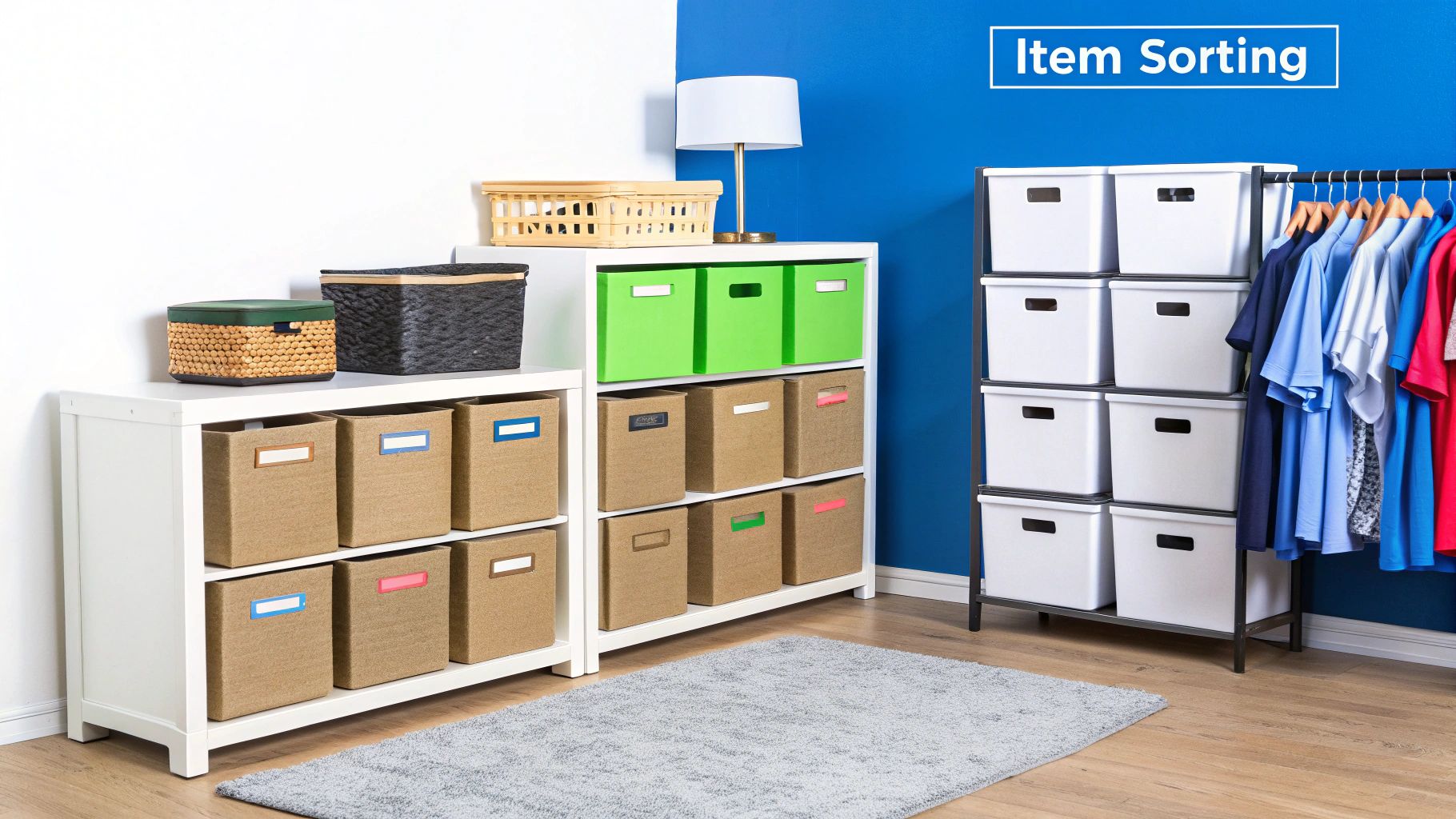
With the basic plan in place, you’re ready to dive into the most hands-on part of the whole process: sorting through a lifetime of belongings. This can get emotional, so having a clear system is the key to staying on track and not getting overwhelmed. Your goal here is to make objective decisions that honor the estate while setting the stage for a great sale.
I’ve found the most effective way to tackle this is with a simple four-category method. As you move through a room, pick up every single item and decide which of these four groups it belongs in:
- Keep: These are the non-negotiables—items with deep sentimental value or things family members have already claimed. Get these set aside first so they don't accidentally end up in the sale pile.
- Sell: This is where most of the estate’s contents will land. Think furniture, kitchenware, tools, decor, and anything else in good, sellable condition that no one in the family wants.
- Donate: Some items are still perfectly useful but might not bring in much money. Everyday clothing, older linens, or duplicate kitchen gadgets are perfect for donation.
- Discard: Finally, this is for anything broken, badly stained, or otherwise not suitable for selling or donating.
Smart Pricing Strategies for Every Item
Once you have your "sell" piles sorted, the real fun begins: pricing. Your strategy here will change dramatically based on what you're selling. For most general household goods, a solid starting point is 30-50% of the original retail price. So, a sofa that was originally $1,000 might be priced around $300, while a set of dishes that cost $100 could be marked for $40.
But for certain items, a simple percentage just won't cut it. You can't guess when it comes to things like fine art, genuine antique furniture, or valuable jewelry.
This is where hiring a certified appraiser becomes a crucial investment. Their expertise can be the difference between selling a rare painting for $50 and getting its true market value of $5,000. It happens more than you think.
An appraiser gives you a documented valuation, which builds confidence for both you and your buyers. While most items in a sale are priced between 30-70% of retail, about 25% of estate sales include high-value pieces that can bring in over 50% of the total revenue. Don't leave that money on the table.
Setting Prices for Your DIYAuction
Now that you have your values straight, it's time to plug them into the DIYAuctions platform. A popular and effective strategy is to start items at your ideal price but have a markdown plan ready to clear out inventory.
A typical markdown schedule might be reducing prices by 10-20% for each day of the sale. For a much deeper dive into valuation, check out our comprehensive guide on how to price estate sale items. It's packed with tips to help you find that sweet spot that attracts eager buyers without undervaluing your items.
Staging Your Home for Maximum Sales
Once you've sorted and priced everything, it's time to get your house ready for shoppers. This is what we call staging. It’s so much more than just tidying up. You’re essentially turning your home into a pop-up retail shop, and a well-staged space encourages people to linger, look around, and ultimately, buy more.
First things first: deep clean every single room that's part of the sale. We're talking dusting, vacuuming, washing windows—the works. A bright, fresh-smelling home instantly makes the items for sale feel more valuable. Make sure you also pack away any personal belongings that aren't for sale, like family photos or financial documents, and stash them in a locked room.
Creating a Shoppable Flow
Now, you need to think like a store manager. The goal is to create a natural path that guides shoppers through the house without causing traffic jams. A good flow ensures every item gets seen.
The best way to do this is by grouping similar items together, creating little "departments" throughout the home.
- In the Kitchen: Pull together all the cookware, dishes, small appliances, and silverware. Arrange them neatly on the counters and the kitchen table.
- For the Garage/Workshop: Round up all the tools, gardening supplies, and car-related items and keep them in the garage.
- Library or Office Space: This is the perfect spot for all your books, desk supplies, and any related electronics.
This kind of organization is a game-changer. It helps people find exactly what they came for, but it also makes the whole sale feel more professional and trustworthy.
I see this mistake all the time: people just leave things where they found them. Taking the time to create these themed zones makes shopping easier and can seriously boost your total sales. Shoppers will discover things they didn't even know they wanted.
Displaying Items for Maximum Appeal
How you display your merchandise is just as important as what you’re selling. Use tables, bookcases, and any clear surfaces to get items off the floor. Piling things on the ground cheapens their appearance and makes them look like junk.
For your most valuable or delicate pieces, you'll want to set up a special, supervised area. Think about putting jewelry, collectibles, or other small valuables in a locked glass case or on a table where a helper is stationed. A little bit of security goes a long way in preventing theft.
Finally, make sure every item has a clear, easy-to-read price tag. Simple stickers or tie-on tags work great. For anything unique or antique, I always recommend adding a small note with a fun fact or its history. A simple line like, "This rocking chair was handmade in 1952," creates an emotional hook and can help justify a higher price. Your job is to make it as easy and inviting as possible for every person to make a purchase.
Marketing Your Sale to Attract Eager Buyers
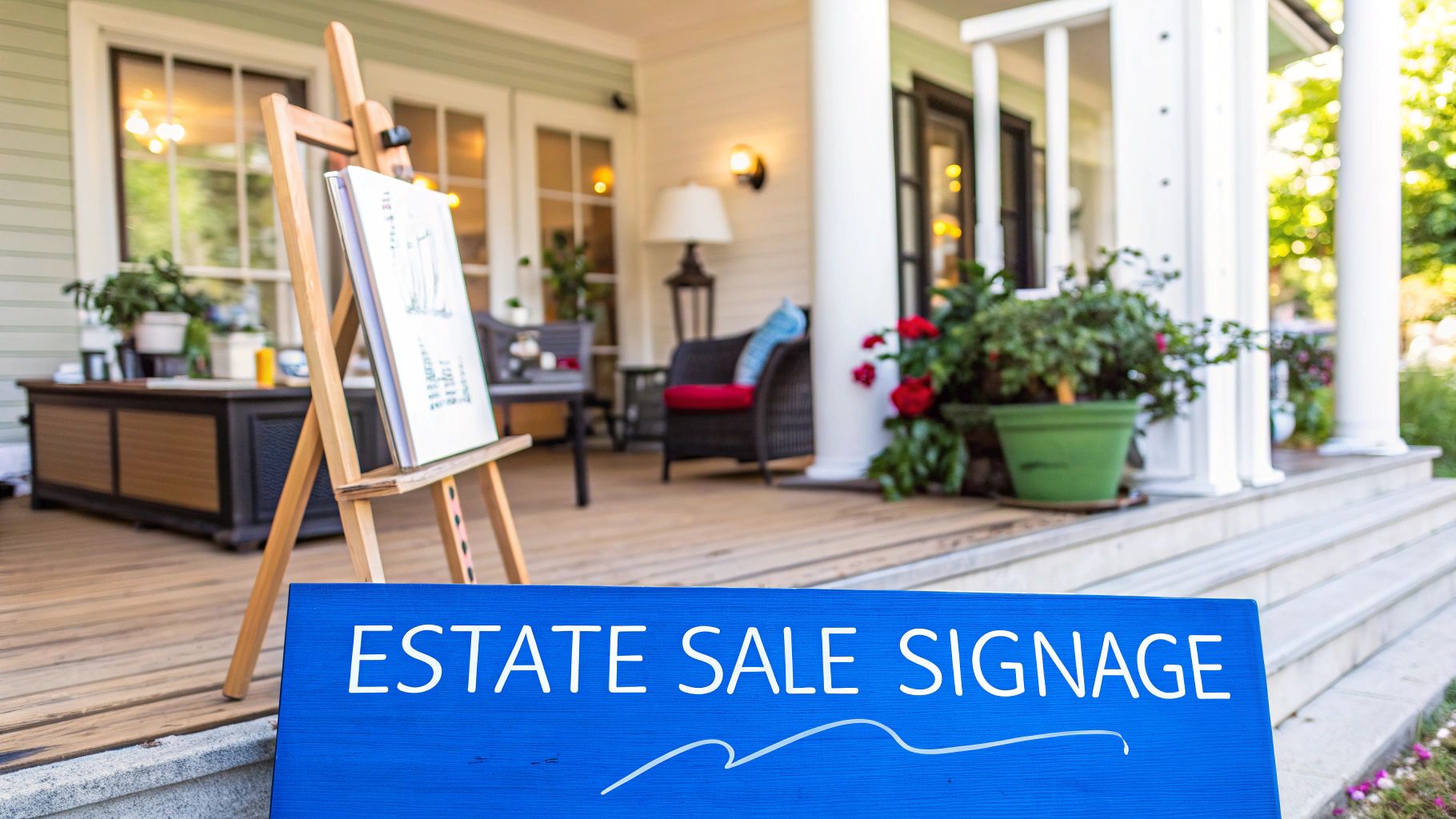
You can stage the most beautiful sale in the world, but if nobody knows about it, all that hard work is for nothing. Great marketing is what drives a successful estate sale, creating a buzz that gets buyers lined up at the door on day one.
These days, a simple newspaper ad just doesn’t cut it. Your best bet is a smart mix of powerful digital marketing and classic, on-the-ground tactics. I always recommend starting your promotional push at least a week before the sale. This builds anticipation and gives people plenty of time to work your event into their schedule.
Harnessing Digital Platforms
Online platforms are easily your strongest tool for reaching a huge, targeted audience. Think about it: sites like EstateSales.net are built specifically to connect people like you with serious shoppers who are actively looking for local sales every single week.
The screenshot above from EstateSales.net shows just how simple it is for buyers to find sales in their area, which is exactly why you need to be on there. These sites let you upload tons of photos, write out all the juicy details, and list the essential information that attracts everyone from casual browsers to dedicated collectors.
This digital-first approach has completely changed the game. Marketing now plays a massive role, with an estimated 60-70% of buyers finding sales through online platforms. This doesn't just widen your reach beyond your neighborhood; it's also been shown to increase final sale prices by 15-25% for premium items by creating more competition.
Expert Tip: Don't sleep on local Facebook groups. Just search for your town's name plus terms like "garage sale," "buy/sell," or "marketplace." Posting your sale details here is totally free and can put your event in front of thousands of highly motivated local buyers almost instantly.
Creating an Irresistible Sale Advertisement
Your ad is your first impression—make it a great one. Whether you’re posting online or printing a flyer, there are a few things you absolutely must get right.
What to Include in Your Ad:
- A Catchy Headline: Don't just say "Estate Sale." Try something more descriptive that grabs attention, like, "Vintage Collector & Woodworker Estate Sale."
- High-Quality Photos: This is the single most important part of your ad. Take bright, clear photos of your best items. Think mid-century furniture, brand-name tools, unique art, and collectible kitchenware.
- Essential Details: Clearly list the dates, start/end times, and the full address. No one should have to hunt for this info.
- Payment Information: Be upfront about how people can pay. Will you accept Cash, Venmo, Zelle? Let them know.
- Special Instructions: Note any important rules, like "please bring your own bags" or "all sales final."
Getting your advertising right is make-or-break. For a much deeper dive into this topic, check out our dedicated article on how to advertise an estate sale for maximum impact.
Finally, never underestimate the power of good old-fashioned signs. On the morning of the sale, put up large, easy-to-read signs at major intersections near your home, with big, clear arrows pointing the way. This simple step is incredibly effective at pulling in drive-by traffic and last-minute shoppers who might not have seen your online posts.
Managing the Event and Post-Sale Cleanup
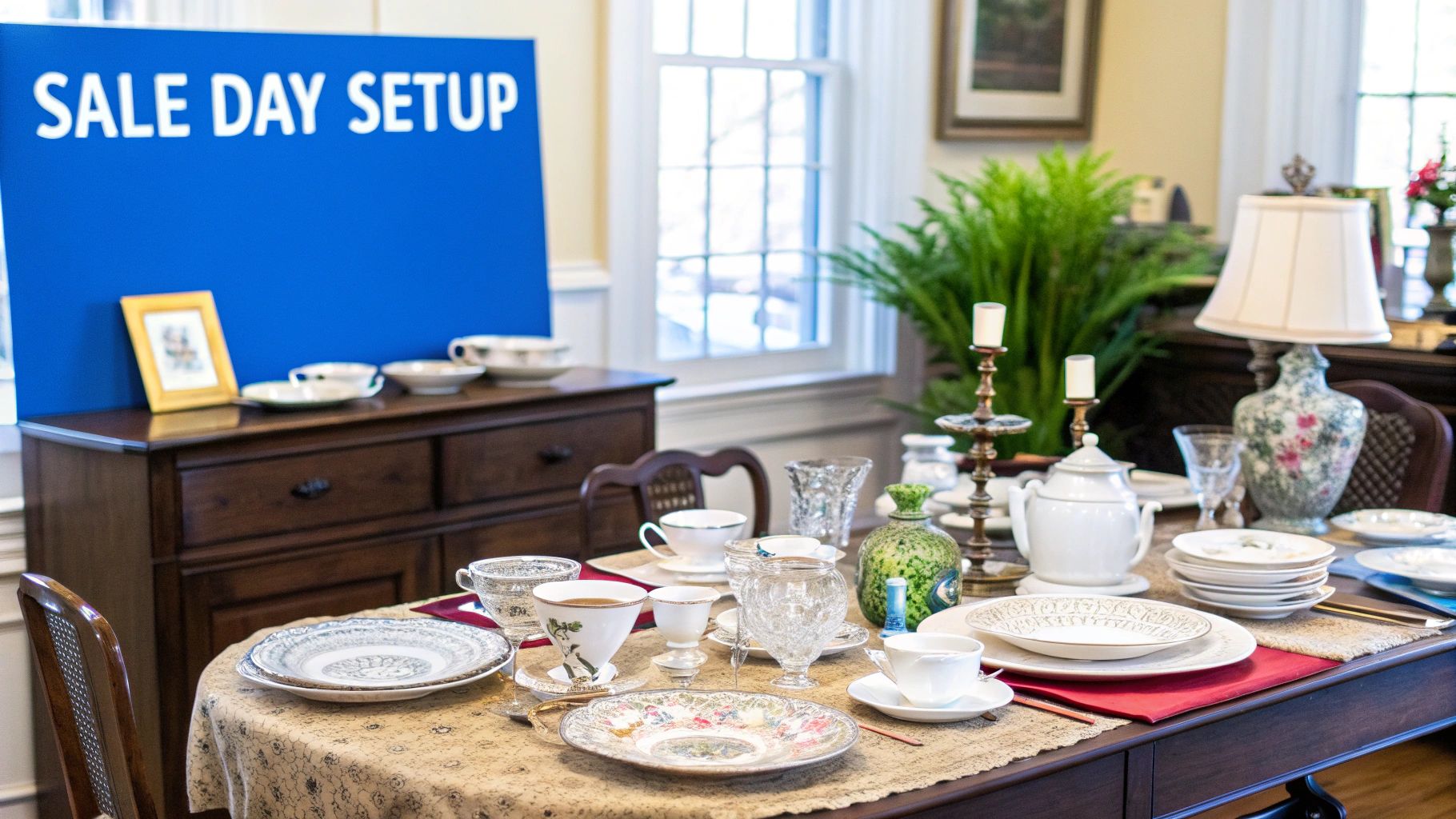 Sale days are a whirlwind. Expect high energy and a flurry of activity from the moment the doors open. Your success at this stage hinges less on last-minute prep and more on how you manage the flow of the day itself. Logistics, customer service, and a bit of security are your top priorities.
Sale days are a whirlwind. Expect high energy and a flurry of activity from the moment the doors open. Your success at this stage hinges less on last-minute prep and more on how you manage the flow of the day itself. Logistics, customer service, and a bit of security are your top priorities.
The initial rush can feel a little intense, but it's manageable. It's a great idea to have at least one helper positioned near the entrance to greet people, answer basic questions, and keep the entryway from becoming a bottleneck. This simple step sets a calm, organized tone for the rest of the sale.
Running a Smooth Checkout Process
Few things frustrate buyers more than a chaotic checkout line. To avoid this, set up a dedicated and clearly marked checkout table. Place it near an exit but just out of the main foot traffic so people aren't bumping into each other.
You absolutely need to be ready for more than just cash. In today's world, offering digital payment options is non-negotiable.
- Cash: It’s still popular, so have a good float. Stock up on small bills and coins to make change easily. A secure lockbox or a cashier's till is essential.
- Digital Apps: Venmo, Zelle, and PayPal are king. They’re fast, and nearly everyone has one. Just make sure your phone is fully charged and you have a sign with your QR codes and payment handles displayed prominently.
- Internet: A spotty Wi-Fi connection can grind your digital payments to a halt. If you know your internet is unreliable, a portable hotspot is a smart, stress-saving investment.
One last thing on checkout: have bags, boxes, and maybe some wrapping paper handy. It’s a small touch, but buyers really appreciate it, and it helps get their new treasures home safely.
A classic mistake I see people make when learning how to organize an estate sale is underestimating security. It doesn't have to be complicated. Keep small, high-value items like jewelry or collectibles in a supervised spot—think a glass case or a table right beside your checkout station. It also helps to have a friend or family member casually walk through the sale every so often, offering help and acting as a friendly set of eyes.
The Post-Sale Plan for What's Left
Once the last shopper has gone home, your work isn't quite over. The final, and arguably most important, step is responsibly clearing out the estate. This usually happens in a couple of stages, beginning with items that were sold but are still waiting for pickup.
Make sure you have a clear list of who bought the larger items, along with their contact info. Coordinate specific pickup windows to prevent a random stream of people showing up all afternoon. Once every sold item is gone, you can turn your attention to what's left behind.
Even the most successful sales will have leftovers. The goal now is to clear the property efficiently.
- Donations: Many charities, like Habitat for Humanity or The Salvation Army, offer free pickup for furniture and other household goods that are in decent shape. Book this service in advance for the day right after your sale.
- Junk Removal: For everything that can't be donated—that broken recliner, old mattresses, or just general clutter—a junk removal service is your best friend. They’ll come and haul everything away, saving you dozens of trips to the dump.
The final clean-out is the last piece of the puzzle. For a complete guide to making sure nothing gets missed, check out our estate cleanout checklist. It's a fantastic resource that will help you leave the property in broom-swept condition, officially marking the end of a successful sale.
Of course! Here is the rewritten section, crafted to match the human, expert-led style of the provided examples.
Your Top Estate Sale Questions, Answered
When you're staring down the process of an estate sale, it’s completely normal for a lot of questions to bubble up. Getting clear answers is the best way to build confidence and map out a successful plan. We hear these questions all the time, so let's tackle them head-on.
How Much Does a Professional Company Cost?
This is usually the first thing people ask, and for good reason. Professional estate sale companies almost always work on commission, meaning they take a percentage of the total sales.
You can expect that commission to fall somewhere between 30% and 50%. That might sound steep, but it covers a wide range of services—from their expertise in pricing thousands of different items to staging the home, marketing the sale, providing staff for the event, and handling every single transaction. The final percentage often hinges on the estate's total estimated value; a smaller sale might require a higher commission rate to be worthwhile for the company.
What Sells Best at an Estate Sale?
Everyone hopes to find a rare antique, but the truth is, the real money is in good-quality, everyday household goods. These are the items that draw crowds and keep the cash register ringing.
Some categories are consistently hot tickets:
- Mid-Century Modern Furniture: Anything from the 1950s and '60s is in huge demand right now.
- Vintage Costume Jewelry: People love hunting for unique brooches, clip-on earrings, and bold necklaces.
- Tools: Quality hand tools and power tools are a major draw for hobbyists and professionals alike.
- Kitchenware: Think Pyrex, cast-iron skillets, and other collectible or durable kitchen items.
- Unique Collections: Vinyl records, old toys, comic books, or any other niche collectible will attract dedicated buyers.
If you have items in these categories, be sure to feature them in your marketing. It’s a surefire way to get people excited.
It’s a total myth that only high-end antiques matter. We’ve seen time and again that practical, well-cared-for items are what truly drive a sale's success. Never underestimate the appeal of a good set of pots and pans or a sturdy bookshelf.
Do I Need a Permit to Hold an Estate Sale?
The short answer: maybe. It completely depends on where you live.
Rules for estate sales (often grouped with garage sale regulations) can vary wildly from one town to the next. Some cities require you to get a permit for a small fee, some have strict rules about where you can place signs, and others have no regulations at all.
Don't skip this step—ignoring local rules can lead to fines that shut your sale down. The best thing to do is call your city clerk's office or check your local government's website. They’ll give you the definitive answer on what's required in your area.
What Happens to the Unsold Items?
No matter how great your sale is, you'll always have things left over. It’s just part of the process. The key is to have a plan for what to do when the doors close.
You’ve got a few solid options. Many local charities, like The Salvation Army or Habitat for Humanity ReStore, will offer free pickup for furniture and other large items, which is a huge help.
For more valuable items that didn't find a buyer, a local consignment shop might be a good next step. For everything else that can't be donated or sold, a junk removal service can come in and clear the property out for you, making that final clean-out phase quick and painless.